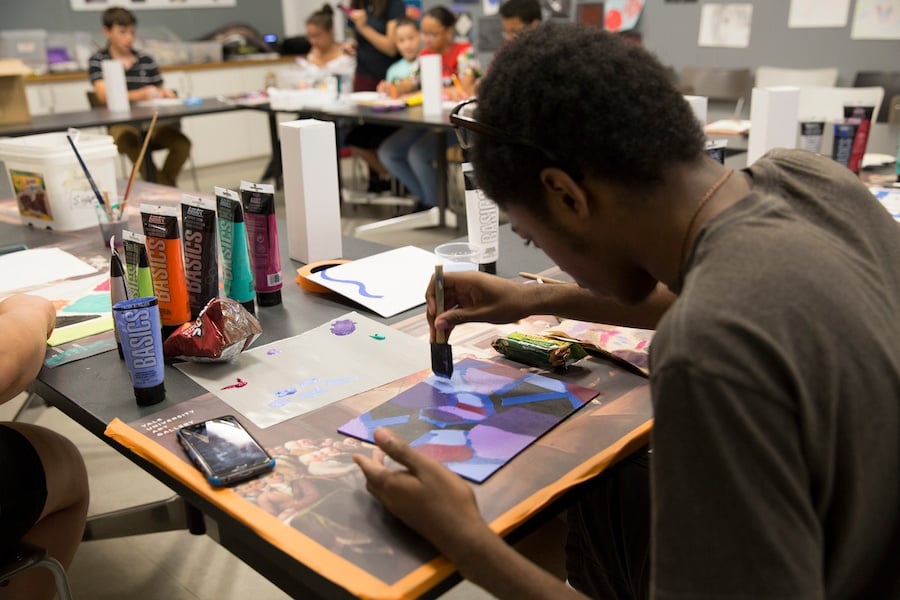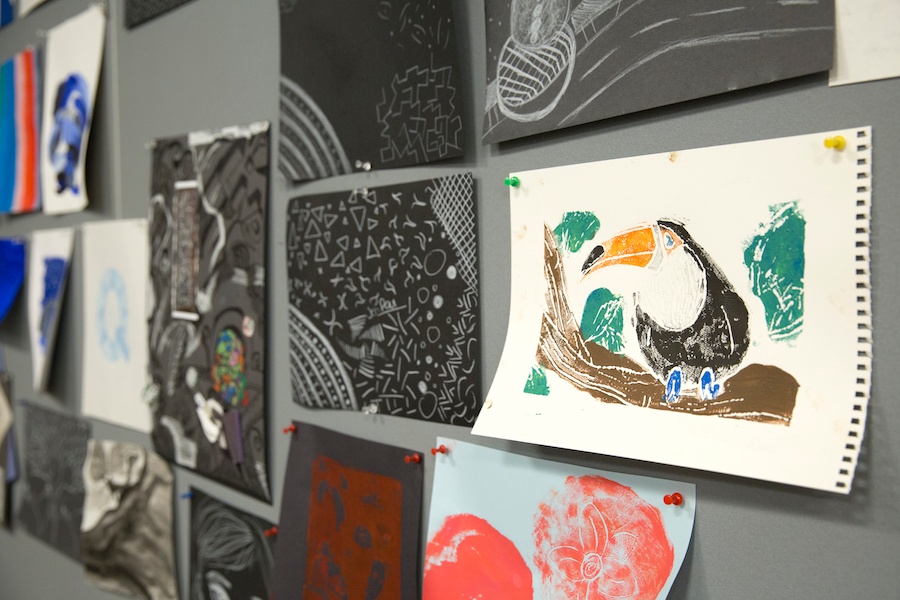
Jessie Smolinski Photos, Courtesy Yale University Art Gallery.
“Moose” remembers the first time she learned about Yale University Art Gallery’s (YUAG) Teen Program. It was a summer afternoon, and she was stressed out after work. Her friend invited her to the gallery, where they could skip looking at the art upstairs and make their own in the basement. She’s been coming back ever since.
Moose is one of hundreds of New Haven students to frequent YUAG’s Teen Program as it catches on in the wider community. Colloquially dubbed the “Varsity Art League” by its attendees, the program is held Wednesdays from 3 to 4:30 p.m. in the gallery’s sub-level studios beneath High and Chapel Streets. To ensure that transportation and food security aren’t barriers to entry, the gallery provides bus passes and snacks to participants.
It’s become “a second home” to Moose, a student at Cooperative Arts and Humanities High School (Co-Op). A poet by practice—she has one compilation out and another volume on its way—Moose said she found painting a welcome release from the constant, writerly pressure to find the right words.
“I was instantly really comfortable,” she said.
That’s by design. Inspired partly by the ARTLAB+ initiative at the Hirschhorn Museum in Washington, YUAG’s education department built its recurring after school event as a loosely structured, drop-in workshop that currently accommodates 20-40 kids. The education department purposefully opted against curricula with fixed outcomes, or an application-only steering committee.
“We didn’t want to do something that was so exclusive kids would get turned away,” said Jessica Sack, Jan and Frederick Mayer Senior Associate Curator of Public Education.

Instead, it’s based around a teaching method known by its acronym HOMAGO—Hang Out, Mess Around, Geek Out. Teen Program participants receive unlimited access to a wide range of crafts supplies and the license to freely experiment with them. There are off-the-shelf acrylics and temperas, watercolors and accompanying wax and oil resists, artist-grade sketching materials. Attendees often request particular materials, like a set of brush-tip pens to fill the gap between painting and drawing.
At these sessions, a handful of floating Wurtele Gallery Teachers mingle among the teens to offer technical assistance. Recruited across Yale University’s body of graduate and professional students, they mostly adopt a hands-off approach, delivering up their know-how on-demand.
Sack noted that teachers from the School of Art distinguish themselves—when participants burningly need to know “How do I make it look like that?” the practicing Master’s students can do tutorial right then and right there. But all of the gallery teachers are there to help.
“If we’re sometimes doing a really messy project—like printmaking—we’re there to facilitate every step,” Sack said. But “the kids are very engaged in their making,” and don’t always need extra assistance.
Instead, they tend to give at least a full hour of Teen Program’s time to art, after obligatory banter (“That’s lit.” “Define, ‘lit,’ please?” “I drink coffee.” “I was being careful not to kick Matt.”) and some grazing.
Over four years, the result has been a program focused on autonomous discovery, unique from the classroom visits and student tours to YUAG’s exhibition spaces. Sack recalled once asking a participant: “Is this like what you do in school?”
“There’s no way you could be like school,” the student answered.
Rylan Mayo, attending a recent session after a full day of midterms at Co-Op, confirmed this. When his Co-Op art class comes to the museum, he noted that “we’re learning about the art instead of applying it.”
But working in the program after school, he indicated he has other options. Like the creative competition he had going with his friend Kevin Padilla, seated to his left. That afternoon, their good-natured rivalry was shaping up as the Renaissance debate between disegno and colore—line and color.

Rylan defined a full-face portrait of a floppy-eared basset hound or Dalmatian in delicate, graphite tracery. Kevin had rendered red-orange nebulae with a heavy, goopy facture on a mauve, galactic void.
“I like space; it’s really cool,” said Kevin. “I associate space with the color purple … then I add the stars.”
Asked if he considered himself much a painter, Kevin responded candidly: “No, I’m really bad at it—but, I’m practicing!”
That’s true for many of the participants in the program. Sack recalled how one attendee followed through on a single painting project over three consecutive months. In that time, she watched him experiment with process, dabbing the paint just-so or trying out new brushstrokes.
That learning process goes both ways. Jenny Calivas, a photography MFA in her second year, was one of the assisting gallery teachers that afternoon. At work cutting out kits of readymade felt shapes for an upcoming K-5 event, she spoke at length about her involvement in the Wurtele Gallery Teacher Program, which trains its new fellows for months at a time to lead encounters based around art objects.
The gallery teachers pitch in for happenings like Teen Program put on by YUAG’s education and public programs departments. They spend the bulk of their time, however, conducting tours for all sorts of audiences.
The tours deemphasize art historical content and tend to value the voice of the average beholder. Question stems like “What do you see?” and “What do you see that make you say that?” assume that a group of high schoolers has its own intuitive taste, challenging students to take the time to look closely.
“This is really special because you’re able to slow down with the kids,” Calivas said. She recalled walking one high school tour through an exhibition of Thomas Wilfred’s Lumia—variable-geometry light sculptures that crawled and pulsed. It complicated the prompt “What do you see?” because what they saw shifted all the time.
That kind of interpretation unfolds at the Teen Program too. Back at the session, Moose walked up to Sack, who was seated with two other students and taking turns at adding lines to a Sol LeWitt-inspired collaborative drawing. Moose flashed an artboard bearing an iridescent pink and blue disruption pattern over the day’s second purple background.
“The color of feminism,” Moose proclaimed. Sack asked her where it began.
“You see this big blotch of paint in the middle? That’s where I started,” Moose said. “I added blue to it because it’s too pink.”
“Did you put your name on it?” Sack asked.
“No.”
“You didn’t put your name on it,” Sack asked again, fake cross. She gestured for Moose to come over and bring her a marker, and to show her the still-wet board’s backside.
Sack inscribed Moose’s name—contributing a necessary clerical touch—and Teen Program continued on. Moose air-launched a package of fruit snacks across the room. Chatter burbled up over big-band swing filtering in from a Bluetooth speaker.
“Is ‘failing’ a B+ or is ‘failing’ an F—?” one voice asked. Others followed.
“No, it’s failing. I have an F—”
“I wish I could art.”
“Just do it and see what happens!”